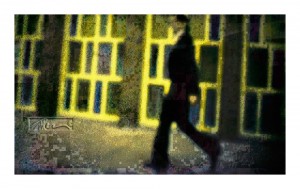“In anticipation of the next Worldwide Pinhole Photography Day, I’ll be producing a number of posts about pinhole imaging.”
Traditionally, pinhole photographs have been pretty much straight out of the box, so to speak.
In the old days of film and paper, there were a only a few photographic controls such as contrast control and toning that were used to enhance the final rendition of a pinhole image. In most cases, the image was pretty straightforward and straight out of the camera. Whatever the camera produced, was the final product. These days, computer software can be useful for taking a pinhole to a whole new level.
It seems that most people who have ever made a pinhole image shoot them as photo emulsion images using a very basic box and in many cases, photographic paper as the light sensitive material. This can be pretty exciting, but it seems rather limiting and doesn’t have to be the only way to do it.
These days, you have a number of choices. First, you can do it the original way by creating any number of light tight boxes and a pin sized opening, or you can do it with a number of digital solutions such as a pinhole body cap mounted to a DSLR or Mirrorless camera. Whatever way you choose, it is possible to scan or transfer the images to your computer so that you might utilize some type of imaging software to alter the look in some new way.
Personally, I find that simply toning the image makes it seem more interesting. However, I usually don’t stop there. I like to enhance the images using the incredible tools available to me through software programs such as Photoshop and image paint applications like Painter and Studio Artist.
I am not suggesting that you alter the image to the point that it is no longer recognizable as a photograph created by the magic of a simple hole in a box. Rather, I am suggesting ways to enhance what some may think as a seemingly limited medium. I am interested in seeking ways to produce new and more exciting pinhole imagery.
For many pinhole photographers, pinhole photography is interesting because it is a unique method of producing a photograph. Pinhole can accomplish many things that digital can’t, and it is magical due to its direct and simple relation to light. So, why not push it to the limits visually?
Here are a few other links to pinhole topics on LensGarden:
- Pinhole Photography – How to measure the diameter of a DIY pinhole aperture
- Pinhole Calculator – How To Use
You can learn about pinhole photography, digital painting and many other imaging techniques from my book.
Read about my book Rethinking Digital Photography.
Please have a look at some of my other posts here.
NOTICE of Copyright: THIS POSTING AS WELL AS ALL PHOTOGRAPHS, GALLERY IMAGES, AND ILLUSTRATIONS ARE COPYRIGHT © JOHN NEEL AND ARE NOT TO BE USED FOR ANY PURPOSE WITHOUT WRITTEN CONSENT FROM THE WRITER, THE PHOTOGRAPHER AND/OR lensgarden.com. THE IDEAS EXPRESSED ARE THE PROPERTY OF THE PHOTOGRAPHER AND THE AUTHOR.





